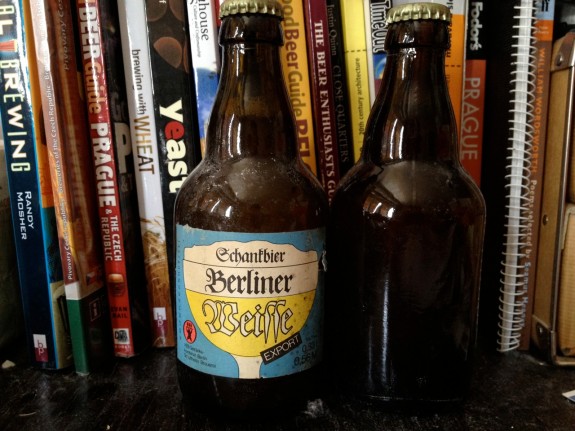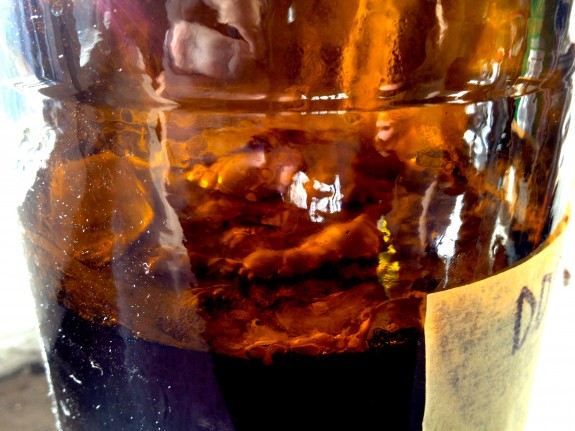
This summer, I bought a couple of pre-1989, East German Berliner Weisse bottles from eBay.de, with no knowledge of how they were stored, nor even where they were produced. After they arrived, I tracked down information in an online listing of historic German beer labels, which indicated that the bottles came from the VEB Getränkekombinat Berlin’s Schultheiss Brauerei, and dated from 1969–1989 — thus at least 23 years old, and possibly even a bit older.
After a couple of months, I opened one.
The beer itself? Dry, thin, gueuze-like, horsey. Extremely sour. Lemony. In a word, weird. In another word, excellent. But that’s not the point.
Far more interesting was what had been going on inside the bottle, and what might be still there. Thanks to Ron Pattinson, more people know that Berliner Weisse used to be made not just with saccharomyces and lactobacillus, but also with brettanomyces. I’ve worked with brett a few times, and I know from personal experience that the various strains of brett have distinctly different characteristics: you won’t get the same flavors from brettanomyces claussenii as you will from brettanomyces bruxellensis. Even two versions of the same strain can be very different: the particular brettanomyces bruxellensis from the great Drei Fonteinen lambic brewery is being propagated and sold by White Labs as its own variety of brett (#644, called “Trois”) as of 2012. Although White Labs already had a brett brux (#650) available, the Drei Fonteinen strain is different enough to merit its own production.
Despite a growing interest in brewing with brettanomyces in recent years, I’ve never seen any commercial yeast labs offering the brett strain from the old East German Berliner Weisse breweries. Andreas Bogk has a project, the Bogk-Bier Privatbrauerei, which aims to bring back the production of Berliner Weisse using the original brettanomyces strain. When I brewed my own Berliner Weisse earlier this year, I didn’t have access to the Berlin strain of brett for it. Adding a Belgian or English strain to a Berlin-style beer could be about as accurate as fermenting a Munich-style Dunkles with a Trappist strain of saccharomyces — meaning not accurate at all.
This is part of what beer culture means: the actual cultures that make beer. When we lose those, we often lose the ability to connect to beer’s history. We lose that shared cultural inheritance. Grodziskie (aka Grätzer) is able to be resuscitated because the yeast was stored in a lab when the last Grodziskie brewery closed in 1993. Bringing back other historic beer styles is harder to do accurately without the right microbes.
The thing about brettanomyces is, it’s a survivor. It can last for a long time after yeast and bacteria — like saccharomyces and lactobacillus — have died off. It can live in a bottle for decades.
So when I finished my East German Berliner Weisse, I saved the last centimeter or so of liquid and sediment and transferred that to a small, sanitized fermenter, to which I added 100 milliliters of fresh wort. Nothing happened.
A week or so later, I added a full liter of new wort. Again, nothing happened.
But when I checked the fermenter a few days after that, a coarse film of big and small bubbles had spread across the top of the liquid. Not a thick kräusen, like you get from saccharomyces. A pellicle, like the ones produced by brettanomyces.

It might be hard to spot through the dark glass of the fermenter in the picture above, but that’s a golf-ball-sized bubble to the left of the frame, with a complete covering of bigger and smaller bubbles across the surface. The fermenter is labelled “DDR Berliner Weisse.”
I have no idea what this particular strain of East German brettanomyces is like, nor how it will ferment, nor how the resulting beer will taste. What I do know is that it is alive. At least something from that bottle is alive. There might be a bit of lactobacillus still working. There might even be a functioning saccharomyces culture, though that seems doubtful. But we’re almost completely certain that the original East German Berliner Weisse brettanomyces culture is healthy and strong — more than 23 years after going into the bottle.




David
Frankenstein lives! This is really awesome, so does this mean you’ll be brewing up a test batch in the near future?
Evan Rail
Thanks, David. It is remarkable that brettanomyces can survive for so long. The German Democratic Republic is long gone, but its culture lives on.
I’ll brew up a test batch in the next month or so, probably 50% wheat, 50% pilsner malt, just to see what happens. One result: we’ll end up with a lot more brettanomyces. All it took was one viable cell, and at the end we’ll have hundreds of billions.
Mike
Evan,
Glad to see you back in the saddle potentially reviving a long-gone culture. Ironically enough I brewed Horner Bier last night…or an attempt at one. All we could get our hands on was 1lb of unmalted oats. 2lbs of flaked oats though so should be plenty sprtizy. Using Roselare to ferment. The real, perhaps rhetorical, question I have after all this, can you brew Grätzer without having Grätzer yeast or ever having tasted Grätzer?
Evan Rail
Hey Mike, thanks for stopping by. Horner Bier is supposed to have Weinstein, aka potassium bitartrate, aka cream of tartar, and I still don’t know how much to add or when you add it. Let us know how yours comes out.
Can you make Grodziskie / Grätzer without the yeast? I don’t think so, because this particular yeast seems to contribute so much to the flavor profile. But you can make something like one, and that can turn into something good on its own. Coincidentally, we just brewed a Grodziskie / Grätzer last weekend at Jopen using the old yeast, Lublin hops and the new oak-smoked wheat malt, as well as willow bark. More on that soon.
Dej bůh štěstí.
Jake S.
Cheers buddy! It’s hero’s like you, working in basements, sheds, and kitchens who are keeping the old cultures alive. Be sure to let us know how this experiment turns out.
Evan Rail
Thanks, Jake — I think this is your kind of business, too. Can you do something with this culture? Let me know if you need few hundred million cells.
Tyler
You’ve no idea how fascinating this post is to me. Ostalgie and Berliner Weisse are two of my favorite indulgences. Anyway, I truly hope this is some interesting Berlin strain of Brett inside this bottle. Haven’t had much luck finishing a Berliner Weisse with Brett myself, as I’ve found it to kind of round out the lactic bite, but I do eagerly await the results of this experiment. Best of luck.
Ron Pattinson
You lucky, lucky bastard getting a bottle of East Berlin Schulthess Berliner Weisse. Easily the best example of the style I’ve had.
Good luck with culturing up the brettanomyces.
Scott
Any updates on this Brett strain?
gavin
did you manage to develop the yeast??